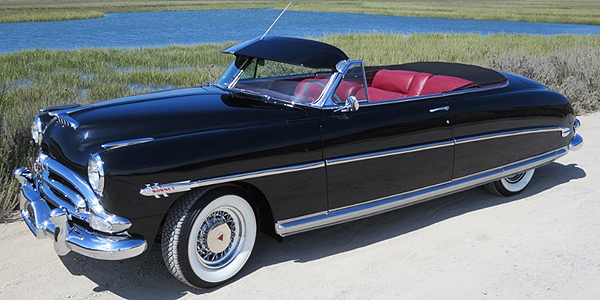Unusual Automotive Treasures
|
Sold for $150,000 on November 23, 2013 Twin H-Power 308 Cubic Inch 6 cylinder win-H-equipped Hornet could run from 0-60 MPH in 12.1 seconds, on the way to a top speed of 107 MPH, and the Hornet proved competitive in NASCAR during the 1953 season, taking victory in 22 out of 37 races. |
| 1953 Hudson Hornet Convertible | |
|
All Hornets from 1951 to 1953 were powered by
Hudson's high-compression straight-six "H-145" engine. In 1954, power
was increased to 170 hp (127 kW) from 145 hp (108 kW). Starting in 1952
an optional "twin-H" or twin one barrel carburetor setup was available
at additional cost. A L-head (flathead or sidevalve) design, at 308 cu
in (5.0 L) it was the "largest [displacement] six-cylinder engine in the
world" at the time. It had a two-barrel carburetor and produced 145 hp
(108 kW)[3] at 3800 rpm and 275 lb·ft (373 N·m) of torque. The engine
was capable of far more power in the hands of precision tuners,
including Marshall Teague, who claimed he could get 112 miles per hour
(180.2 km/h) from an AAA- or NASCAR-certified stock Hornet, as well as
Hudson engineers who developed "severe usage" options (thinly disguised
racing parts). The combination of the Hudson engine with overall
road-ability of the Hornets, plus the fact these cars were over
engineered and over built, made them unbeatable in competition on the
dirt and the very few paved tracks of the 1950s. The newly introduced
"Twin H-Power" was available in November 1951 as a Dealer installed
option at the cost of $85.60. An electric clock was standard. In 1952 the "Twin H-Power" version now standard equipment with dual single-barrel carburetors atop a dual-intake manifold, and power rose to170 hp (127 kW; 172 PS). The hood featured a functional scoop that ducts cold air to the carburetors and was considered "ventilation" in 1954, rather than ram air. The engine could be tuned to produce 210 hp (157 kW) when equipped with the "7-X" modifications that Hudson introduced later. During 1952 and 1953 the Hornet received minor cosmetic enhancements, and still closely resembled the Commodore of 1948. The Hornet proved to be nearly invincible in stock-car racing. Despite its racing successes...sales began to languish. Hudson's competitors, using separate body-on-frame designs, could change the look of their models on a yearly basis without expensive chassis alterations whereas the Hornet's modern, sophisticated unibody design was expensive to update, so it "was essentially locked in and suffered against the planned obsolescence of the Big Three General Motors, Ford, and Chrysler automakers. Hudson Hornet 1952 model year production totaled 35,921 units. |

